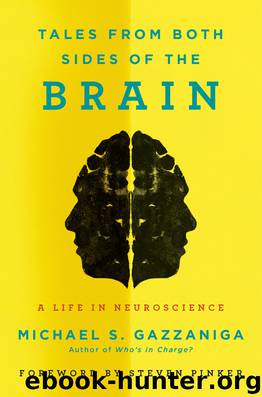Tales from Both Sides of the Brain : A Life in Neuroscience (9780062228819) by Michael S. Gazzaniga

Author:Michael S. Gazzaniga [Gazzaniga, Michael S.]
Language: eng
Format: mobi
Publisher: HarperCollins
Published: 0101-01-01T00:00:00+00:00
MORE FUNDING, MORE RESEARCH, MORE KNOWLEDGE
Meanwhile, many visiting researchers were making a mess of the scientific literature on split-brain patients.7 The researchers seemed not to understand how cross-cueing tricks, used by the split-brain patients to function in the world, could make it look as if their brains were not split. Many concluded, based on this misunderstanding, that there were noncallosal pathways deep in the brain exchanging information. The idea was that split-brain patients might not be so dramatically split after all. If these studies and conclusions were correct, the results of split-brain studies looked very different. Indeed, the very notion that the mind could be divided at its joints was up for grabs.
The proper testing of split-brain patients, while seemingly straightforward, is exhausting. Skilled experimenters have learned through experience and are well aware of all the strategies and tricks patients unconsciously and unintentionally use to cue themselves. They are cross-cueing all the time, and as a result, any experiment is at continual risk of not working properly. Even very sophisticated scientists can fall victim to appearances. We had several such episodes over the years. As a result, from time to time, erroneous messages were being reported and trumpeted in the scientific literature.
One very senior visitor to the lab was my old friend Donald MacKay. He visited while we were still in New York City. He and his physicist wife, Valerie, were dead set on showing that there were not two different agents in one disconnected brain. They had asked to test patients J.W. and V.P., and, of course, we obliged. They were both spectacular scientists and friends. They were not, however, attuned to the tricks of the split brain. The MacKays’ task was to try to get one hemisphere to bet against the other. If it worked, they thought it would demonstrate the presence of two mental systems, each with its own “free will.” They would accept the idea that there were indeed two mental systems, each with its own evaluative system, and that they were wrong. If it didn’t work, they thought that would suggest there were not two minds, but merely two executive systems managing nonessential processing separately or something like that. They set up a clever test, but it was doomed to be nonconclusive because the split-brain patients could cue and control a situation in ways that undercut the experimental design.
In the MacKays’ experiment the first order of business was to communicate to J.W. the idea of how to be a guesser. So in full view of both hemispheres, Valerie wrote a number from 0 to 9 on a piece of paper. J.W. could see it, but Donald, who was going to play the role of guesser, could not. The game would then be that Donald would guess a number, and J.W.’s left hand would be required to answer what he knew by pointing to one of three options printed on a card: “go up,” “go down,” or “OK.” If J.W. had seen Valerie write, say, a
Download
This site does not store any files on its server. We only index and link to content provided by other sites. Please contact the content providers to delete copyright contents if any and email us, we'll remove relevant links or contents immediately.
The Art of Thinking Clearly by Rolf Dobelli(10221)
Mindhunter: Inside the FBI's Elite Serial Crime Unit by John E. Douglas & Mark Olshaker(9201)
Change Your Questions, Change Your Life by Marilee Adams(7635)
Nudge - Improving Decisions about Health, Wealth, and Happiness by Thaler Sunstein(7615)
Mastermind: How to Think Like Sherlock Holmes by Maria Konnikova(7227)
The Power of Now: A Guide to Spiritual Enlightenment by Eckhart Tolle(5605)
Men In Love by Nancy Friday(5155)
Altered Sensations by David Pantalony(5045)
Factfulness: Ten Reasons We're Wrong About the World – and Why Things Are Better Than You Think by Hans Rosling(4694)
The Confidence Code by Katty Kay(4187)
Thinking in Bets by Annie Duke(4152)
Man and His Symbols by Carl Gustav Jung(4069)
The Worm at the Core by Sheldon Solomon(3435)
Why Buddhism is True by Robert Wright(3404)
Liar's Poker by Michael Lewis(3369)
Three Women by Lisa Taddeo(3354)
The Inner Life of Animals by Peter Wohlleben(3259)
Descartes' Error by Antonio Damasio(3230)
How Music Works by David Byrne(3187)
